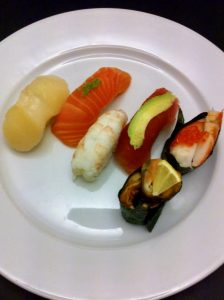
Nigiri sushi is a popular form of sushi which is known for its simplicity and elegance. Technique is used to make small hand rolled pieces of sushi consisting of a rice ball topped with fresh seafood.
It is important to use sushi rice to make nigiri sushi.
A nigiri rice ball is shaped by hand in a special way. To get a specific shape, the experienced sushi chef creates a small air bubble inside the rice ball. The sushi chef makes sure that the texture of the rice is firm enough to hold its shape. It should still soft enough to be edible and not too compact.
The sushi chef adds a small amount of wasabi directly onto a slice of fish. The slices of fish must have the correct size before placing it on the rice ball. With a few fingers and pressure the fish and rice are combined into a piece of tasty nigiri sushi.
Nigiri sushi hand technique requires care and skill to achieve the best result. An experienced sushi chef can create nigiri sushi that melts in your mouth. The perfect balance between the texture of the rice, the freshness of the fish and the taste of wasabi and soy sauce.
Read more about Sushi Chef & Sake Sommelier Zoë Escher
_
Zoë has held sushi courses and cooking classes for A. P. Moller – Maersk, Hugo Boss Nordic, Novo Nordisk, Novartis, Velux, Gorrissen Federspiel, Beierholm revision, Elbek & Vejrup and many more.

